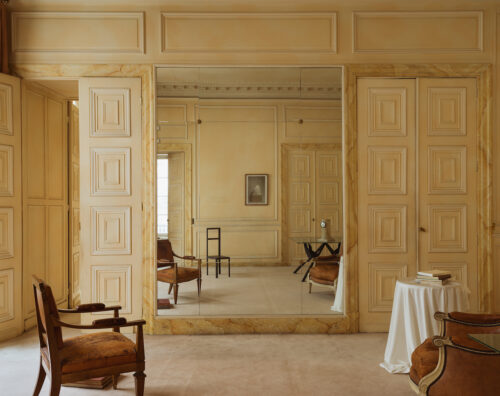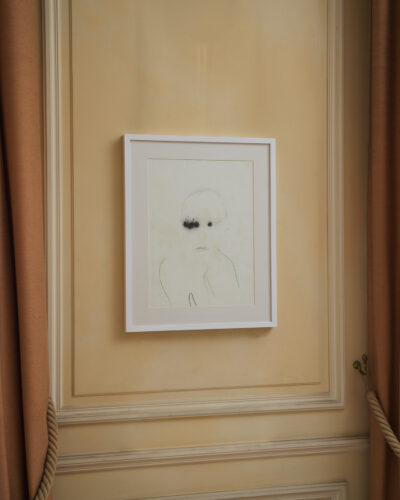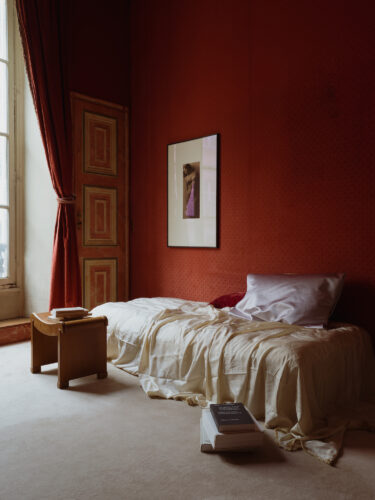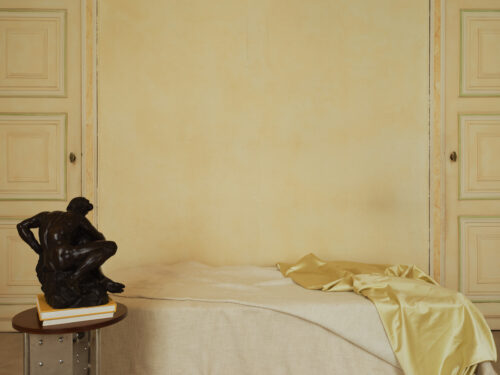TEXT DZENANA MUJADZIC | IMAGES MATTHEW AVIGNONe | FIRST PUBLISHED IN CHAPTER №X “STATE OF THE ART” – SUMMER 2023/24
»In French, we say ça a de l’esprit,« says Paris-based interior designer Marie-Anne Derville, referring in our interview to the exciting interaction and invisible sensual component between people, styles, art, objects and places that she tries to make perceptible with her work.
Chapter You have a very modern approach to setting a room, but it still feels like stepping into another era where everything seemed just a bit more elegant and sophisticated. How much consideration and precision is needed to make your creative work seem so effortless?
Marie-Anne Derville My work stems directly from my life, where I do things both very precisely and very spontaneously, blending rigor with boheme. In terms of creating interiors, I rely a lot on these very spontaneous acts, my instinctive and direct approach, which might be the effortless vibe you’re referring to. I’d further say, my work brings together very consciously made choices mixed with an almost childlike impulse, something to do with play. In the end, it all comes down to the interaction and tension between objects of different values, origins, periods and styles, it’s what creates the desired feeling embedded in harmony. What interests me is the dimension of intellectual, emotional and visual alliance, even if unconscious. A nice interior is like a person’s character – in the end, it’s all about the individual charm.

Chapter Working primarily with vintage objects and artworks that are already charged with meaning and tell their own story – some scream, some whisper, but how do you make sure the tune is just right?
Marie-Anne Derville The search for the right tune is what drives me in my work and my thinking. To me, creating an interior is like writing a score with eighth notes, rests and white notes – it’s about creating tension between moods. In this sense, the true act of creation lies in the subtle art of association. Take Palazzo Cini in Venice, which houses masterpieces by Piero della Francesca and Joseph Beuys under the same roof. That’s the kind of absolute that I am striving for. But how do you create the invisible connection that creates the tangible atmosphere between such opposing masterpieces both speaking their own unique language? To put them in dialogue, it requires you to listen very closely. Harmony works in truly mysterious ways.


Chapter Some things never get old, so speaking of juxtaposing contemporary designs with antique pieces – what does “State of the Art” mean to you?
Marie-Anne Derville It’s the capacity to bring together both the new and the timeless. “State of the Art” means understanding and embracing different time periods, but also rising above them. This principle – as I understand it – is perfectly embodied in Cy Twombly’s work and world view because it’s radically modern, but also steeped in history. His vision permeated all areas of his life, from art to his interiors and houses, his friends and his lifestyle. It was total. Today, there are many stylistic standards, but to me, it always comes down to one’s unique way of perceiving, which is impossible to copy or reproduce.


Chapter Over time, the initial design of a residential space tends to adapt more and more to the people who live in it.
At what point does a project feel completed on your part?
Marie-Anne Derville To me, a private interior project can never be totally completed. A space must continue to evolve, live on. In this regard, collectors are fabulous people because they try to enhance the reality of their everyday lives and homes through aesthetic choices. It’s a form of transcendence. It’s the ever-evolving collection that makes for an interesting interior. I hate these interiors that we see so much of today, where everything is perfectly furnished, flattened, frozen. Interiors should be “dream machines”, creating a bubble that is somehow detached from reality while still being part of it. Even though my approach is much more contemporary, I am very much inspired by figures like Emilio Terry, Charles de Beistegui or Madeleine Castaing. It’s all about being close to life, to movements, to impulses.


